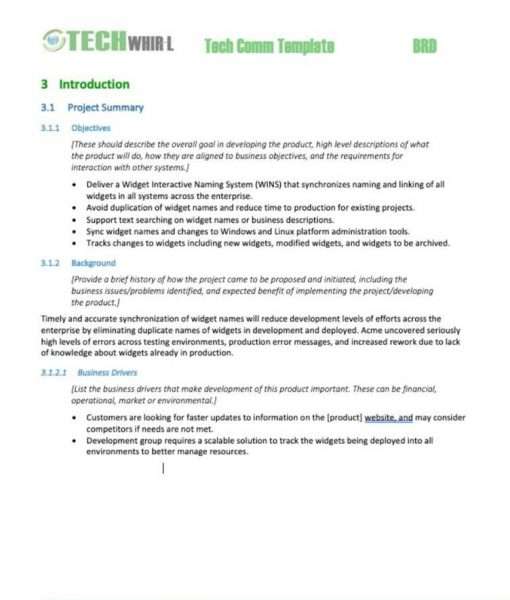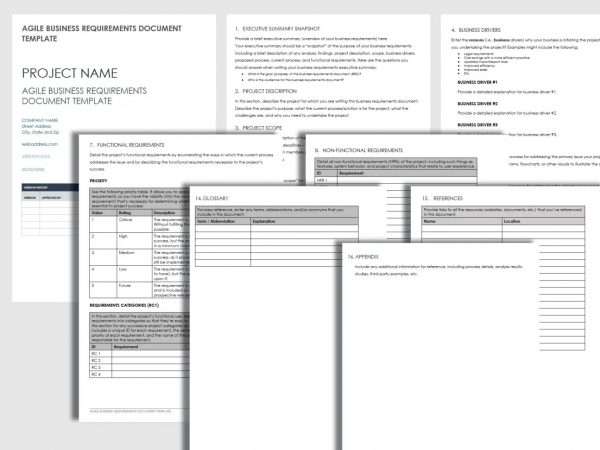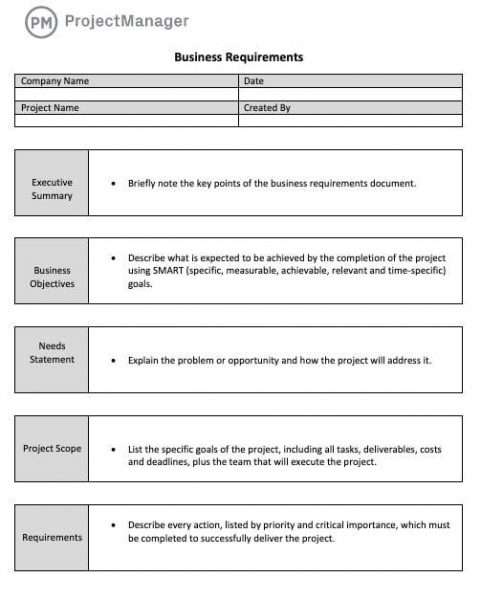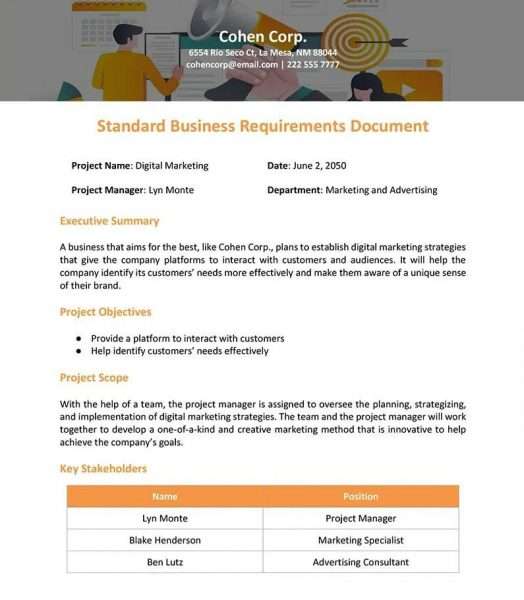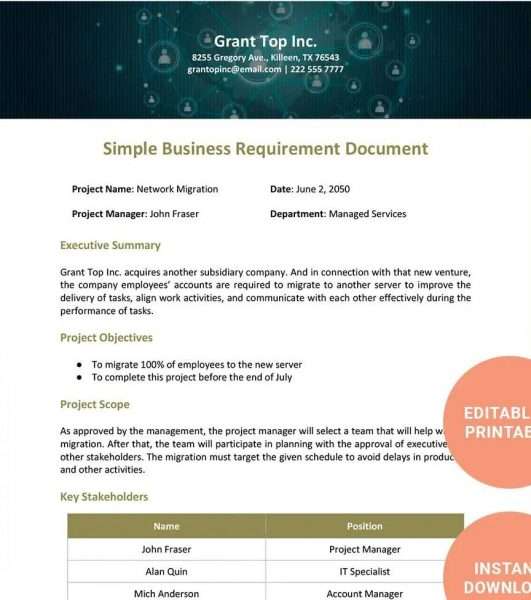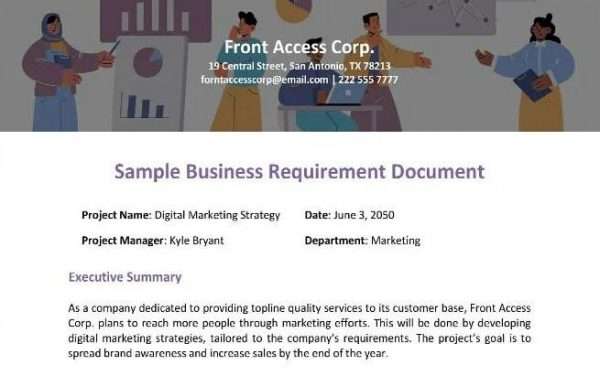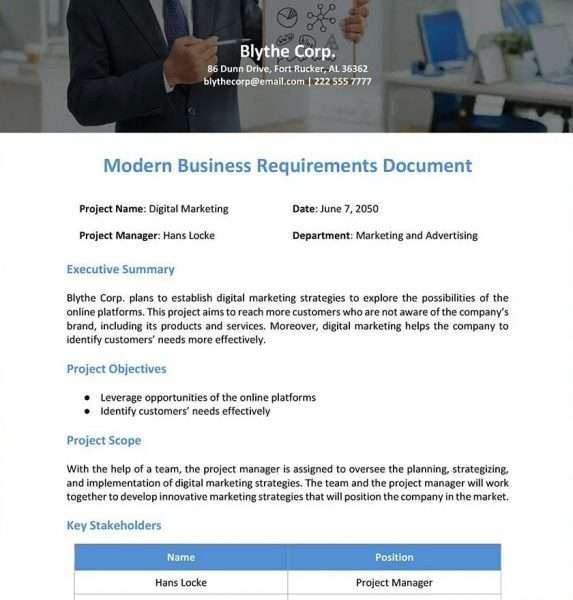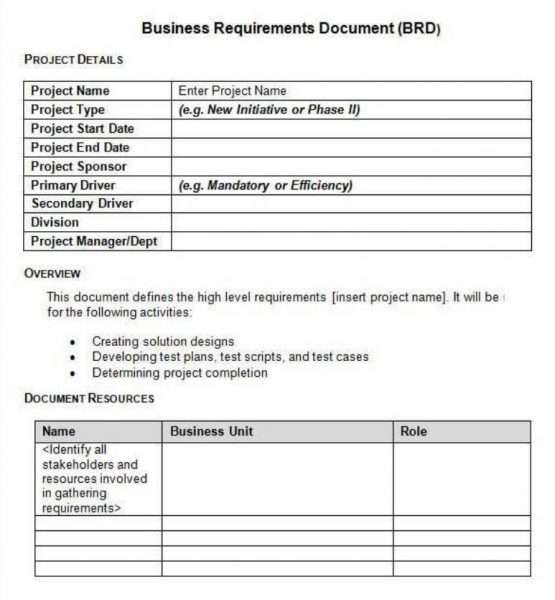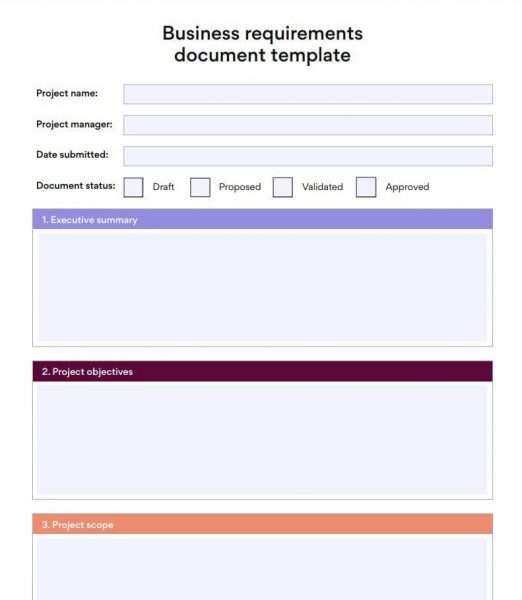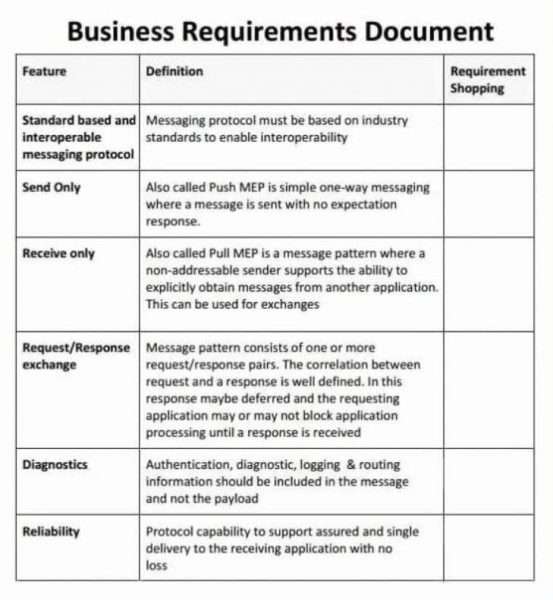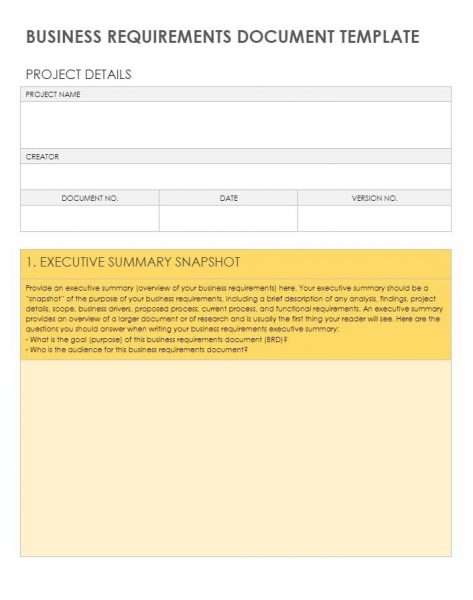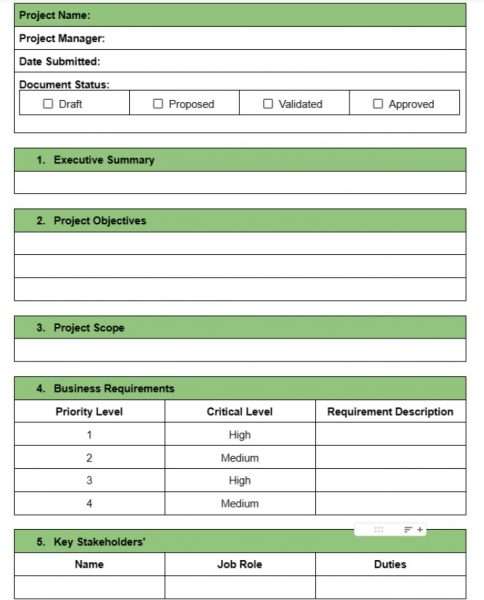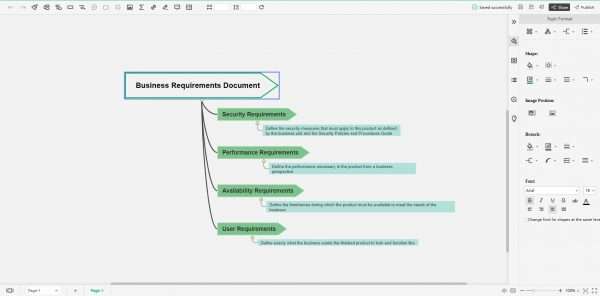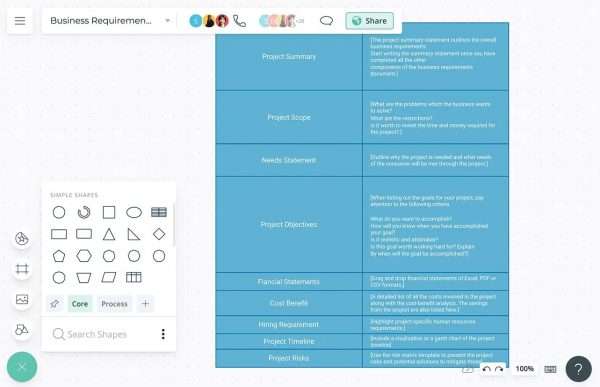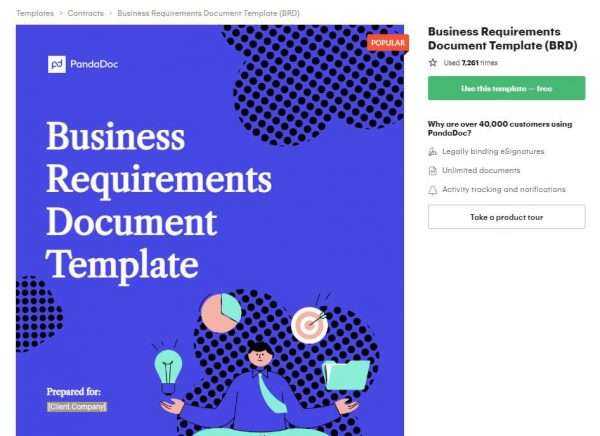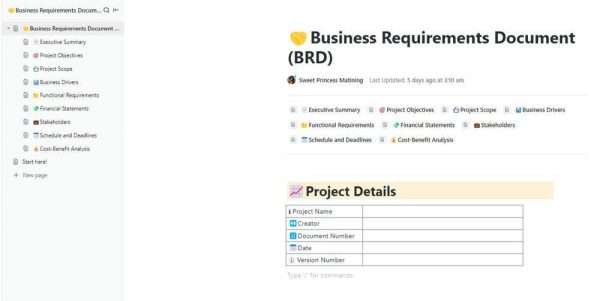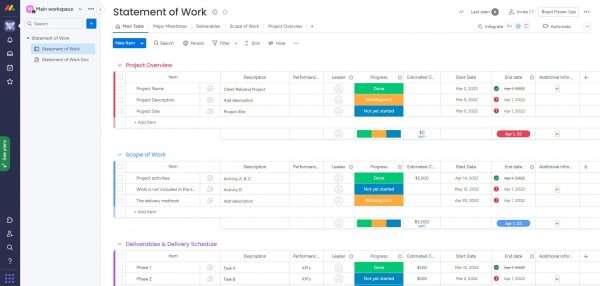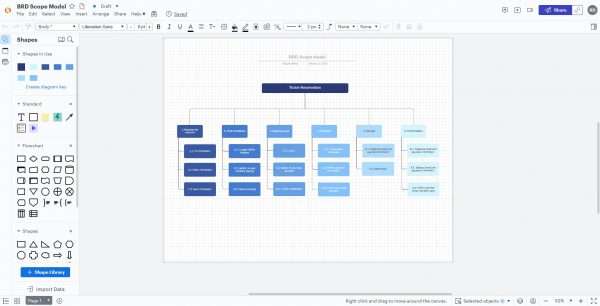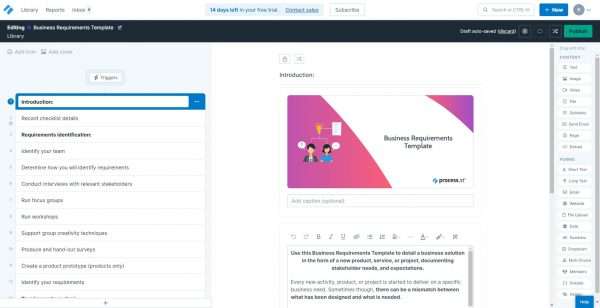An agile business requirements document used to describe the needs for a product or service is called an agile business requirements document. The agile business requirements document describes what the product should do, how it should work, and other details. It is used as part of an agile development process where changes can be made quickly by developers without having to go back to the original document or source code.
This document is meant to make it easy to understand the requirements for future activities in the analysis, architecture, and design in terms of functionality, usability, and quality. Most importantly, it does so in a way that is clear to all business stakeholders.
The agile business requirements document template is meant to help the reader understand everything from the big picture of how the business works to its specific needs. These things need to be included:
- Executive summary
- Project background
- Scope of project
- Business process model
- Project management strategy
- Use cases
- Prioritized requirements
- Assumptions and constraints
- Success metrics
Four reasons why Agile BRD is essential
- It helps achieve consensus among the involved stakeholders.
- Inform the service provider about company requirements, customer requirements, and what the solution must perform to fulfill those needs.
- Identify the project’s contribution to the next phase
- Describe in detail the requirements of the client and the company that the solution will serve.
Agile Business Requirements Document Template Word
Who creates a BRD?
One of the initial few documents produced throughout a project’s lifespan is the agile business requirements document. The project team, business partners, and other important stakeholders are all engaged in the document’s creation, even if a business analyst usually does it. Project sponsors, senior management, middle management, and analysts will be their main target audience.
Agile requirements for user stories
User stories are the smallest work unit in an agile methodology. From the user’s viewpoint, this is an objective, not a feature. It is an informal, customer-oriented description of a software feature.
A user story’s objective is to describe how a piece of work will provide the client with a certain value. They are short, straightforward statements that describe the intended result. They don’t get specific. Requirements are added when the team has approved them.
When a story is finished, you should incorporate it into your development workflow. Usually, the product manager, product owner, or project manager writes a story and sends it to be evaluated.
The team determines what stories to work on at a sprint or iteration planning meeting. Each user story’s functionality and needs are discussed by teams. The team’s execution of the story now has the chance to become creative and technical. Once these criteria are acknowledged, the story is updated to reflect them.
User stories are mostly conveyed using a short phrase with the following structure:
“As a [person], I [want to], [so that].”
Examples:
As Maxi, I wish to invite my friends so that we may all take part in this service.
As Sasha, I want to get my work in order so I feel more in charge.
As a manager, I want to know how my coworkers are doing so I can report on our successes and failures better.
Agile Business Requirements Document Template PDF
How to Agile Business Requirements Document
Before writing the agile business requirements document, these are the steps that had to be taken into account.
1. Begin by studying previous successful projects
Review successful organizing projects if beginning this paper seems difficult. Look at these projects’ documentation and apply your ideas to build your own business requirements document. Consider these factors while reviewing earlier documentation:
- what was successful.
- What failed to work?
- challenges that the team member had to face.
- dependencies that might have an impact on your current project
- Methods of needs elicitation that was used.
2. Gather your requirements
This might include high-level and technical needs. Without obtaining and documenting all stakeholders’ needs, your business requirements document will fail. The “PMBOK® Guide” lists popular requirements elicitation methods, including
- Document Analysis
- Brainstorming
- Focus Groups
- Interface Analysis
- Observation
- Interviews/Workshops
- Surveys/Questionaire
- Prototyping
3. Use simple, non-technical words.
Business documentation like the agile business requirements document may be lengthy and complicated, making it hard for team members to read. Many people in different roles will look at this document, and not everyone will understand the technical content. Therefore, use simple, approachable language in your business requirements document.
4. Add visuals to simplify the content.
Visuals and context may boost your plan’s efficacy and break up words. A common graphic in a business requirements document is a business process diagram. Communicating needs is easier when business processes are mapped out in their present and projected states.
5. Request team feedback.
Ask stakeholders to evaluate your business requirements documentation. This lets the project’s stakeholders give feedback and make changes before the project starts, and it lets you make sure you’ve covered all the requirements. It will also align your team, ensuring success from the start.
Agile Business Requirements Document Template Excel
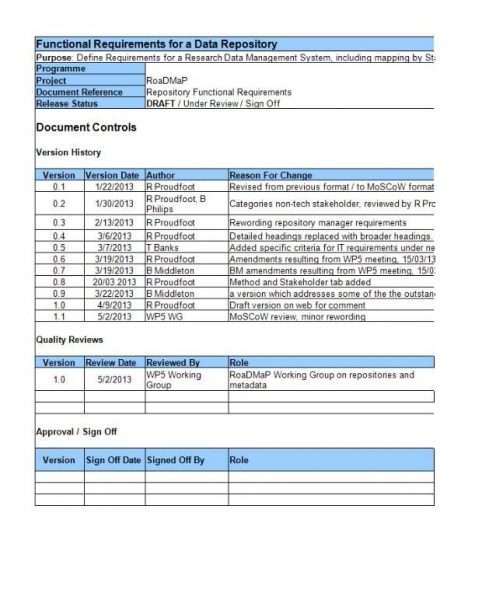
7 main components of the agile business requirement document (agile business requirements document)
The following are the primary elements of agile business requirement documents:
1. Executive summary
The executive summary provides a high-level description of your project’s nature and goals. Reading your executive summary should help others who don’t have time to read the BRD in its entirety grasp what you want to achieve.
Even though it appears first in your BRD, the executive summary should really be written after the other parts. In this manner, you can make sure you’ve written a thorough opening statement by going over everything.
2. Project objectives
The business objectives that you want to accomplish by implementing your project are your project objectives. Before starting any task, it’s crucial to establish your project goals so you can use them to gauge your progress.
In order to make sure your project objectives are SMART goals, they should be as follows:
- Specific
- Measurable
- Achievable
- Relevant
- Time-specific
3. Project scope
In agile business requirements documents, the project scope conveys the project boundaries. By defining the scope of your project, you can make sure everyone is on the same page and avoid scope creep, which is when your project grows beyond the limits you set and becomes hard to manage.
Your project scope should contain the following information:
- Project Team
- Project Requirements
- Deliverables
- Budget and schedule
4. Business requirements
You should outline the steps needed to complete your project in this section. This list might consist of a small number of things or it could be quite long, depending on how difficult the project is. Along with identifying and outlining your needs, prioritize them and give each one a grade depending on how important they are. With this information, other people will be able to figure out which requirements they should finish first.
For instance, if coding a website is one of your needs, you could give this job the highest priority. Because you won’t have a foundation to finish other business needs without creating your website, you may also classify this activity as very important.
Agile business requirements Document Google Docs
Here is an example that shows how to fill out the important parts of the agile business requirements document template.
5. Key stakeholders
All individuals having an interest in your project are considered project stakeholders. These are the individuals who will probably read your agile business requirements document template to learn more about the project. Your principal stakeholders could be:
- Clients
- Project Managers
- Executives
- Team members
In this section, write down the name, position, and responsibilities of each stakeholder and explain how they are related to the project. This part will help everyone understand who else is involved and may make it easier for the team to talk to each other.
6. Project constraints
The project boundaries are already covered in the project scope, but in this section, you’ll go into greater depth about them. After reading this section, the reader should be able to figure out how the project is put together and what its limits are.
Following are the possible constraints that may include:
- Project Budget
- Resources
- Deadline
- Project dependencies
- Team availability
7. Cost-benefit analysis
A cost-benefit analysis at the end of your agile business requirements documentation is a smart step. This part can be crucial if you’re using your agile business requirements document to get permission for your project. The project goal is important to clients and executives, but if you can’t show that you’ll generate a profit, then everything is gone.
Following are the steps involved in creating the cost-benefit analysis:
- Describe all the expenses incurred for your project.
- Describe the advantages that result.
- Write down the whole anticipated cost of your project.
- Calculate the projected return on investment (ROI) by deducting your estimated expenditures from your anticipated revenue.
Agile Business Requirements Document Template Online Tool
Agile Business Requirements Document Template FAQs
What is BRD and FRD in Agile?
The Business Requirement Document (BRD) describes the high-level business needs, while the Functional Requirement Document (FRD) describes the functions that are needed to meet the business need. The functional requirements document (FRD) is a list of how an application needs to work. It does the same thing that a contract does. The development teams agree to give the features that were asked for. The client agrees that the product will be good enough if it can do what is written in the FRD.
What are the criteria of a good BRD?
A good Business Requirements Document (BRD) has project goals that are SMART: specific, measurable, achievable, realistic, and time-bound.
A good BRD outlines the need statement appropriately, which addresses all the main points of the project. It assists in gaining the confidence of important stakeholders.
How many pages is a BRD?
The average BRD is only 3–4 pages long. They must be written in prose so that the writer can clearly explain the requirements, and they should include visuals when necessary or possible to do so.
FRD vs Business Requirements Document
People sometimes mix up an agile business requirements document with a functional requirements document, but it’s crucial to understand the distinction between the two. The agile business requirements document lists all of the project’s main needs and gives an overview of the whole thing.
What is SRS or Software Requirement Specificationused for?
The Software Requirement Specification, also known as the SRS Document, is one of the most important documents for the development team. It is a full explanation of how a system will work when it is built. It outlines what needs to be done to meet the business requirements. It includes all of the system’s properties, business requirements, constraints, and behaviors, like how fast it responds, how reliable it is, how much space it needs, etc. So, it’s also used to estimate how much money and time will be needed to make that software.

